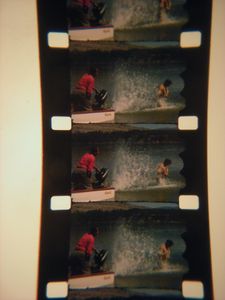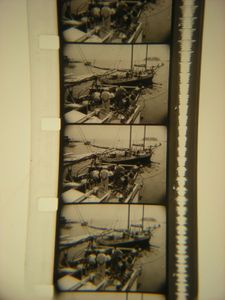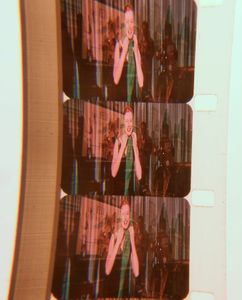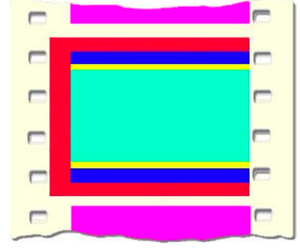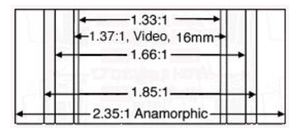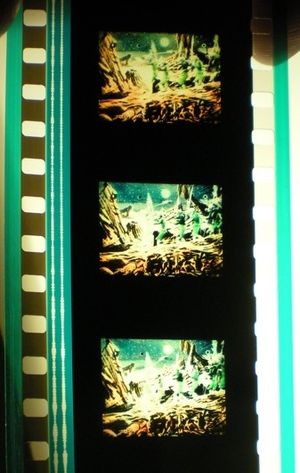| Welcome to Sprocket School! This project is maintained by volunteer editors. Learn more about how this works. |
Aspect ratios: Difference between revisions
No edit summary |
No edit summary |
||
| Line 1: | Line 1: | ||
[[File:35mmaspectratios.JPG|right|thumb|300px]] | [[File:35mmaspectratios.JPG|right|thumb|300px]] | ||
The '''aspect ratio''' is the ratio of the projected image's width:height when projected on the screen | The '''aspect ratio''' is the ratio of the projected image's width:height when projected on the screen or printed on the film. | ||
| Line 12: | Line 10: | ||
The [[16mm]] frame has a native full-frame aspect ratio of nearly (though not exactly) 1.33:1. This is the aspect ratio of the vast majority of 16mm prints. | The [[16mm]] frame has a native full-frame aspect ratio of nearly (though not exactly) 1.33:1. This is the aspect ratio of the vast majority of 16mm prints. | ||
Other 16mm aspect ratios exist, however. Some prints are hard-matted to widescreen aspect ratios like 1.85 and 1.66 (this is seen with some frequency on 16mm reductions of widescreen feature films originally released on 35mm). | Other 16mm aspect ratios exist, however. Some prints are hard-matted to widescreen aspect ratios like 1.85 and 1.66 (this is seen with some frequency on 16mm reductions of widescreen feature films originally released on 35mm). | ||
Anamorphic 16mm prints also exist. These have an aspect ratio of 2.66:1 (because of the native 1.33 aspect ratio of the frame). Note that this means that anamorphic 16mm reductions of films originally released as 35mm anamorphic will be cropped slightly at the top and bottom of the frame! | Anamorphic 16mm prints also exist. These have an aspect ratio of 2.66:1 (because of the native 1.33 aspect ratio of the frame). Note that this means that anamorphic 16mm reductions of films originally released as 35mm anamorphic will be cropped slightly at the top and bottom of the frame! | ||
16mm was historically used for the distribution of Hollywood releases to nontheatrical venues (schools, prisons, summer camps, etc.) as well as for television broadcast. Further variations related to aspect ratio crop up on prints that were used for these purposes. These include simple cropping of widescreen or CinemaScope images to 16mm's native 1.33 as well as "[http://en.wikipedia.org/wiki/Pan_and_scan pan and scan]" efforts. | |||
<gallery widths=300px heights=300px> | <gallery widths=300px heights=300px> | ||
| Line 34: | Line 36: | ||
{| class="wikitable sortable" | {| class="wikitable sortable" | ||
|- | |- | ||
! Aspect Ratio !! Other names !! Year of Introduction !! Image !! Notes | |||
|- | |||
| 1.33:1 || Silent / Full Frame || 1907 || || | |||
|- | |- | ||
| 1.19:1 || Movietone || 1926 || || | |||
|- | |- | ||
| 1.37:1 || Academy ratio || 1932 || || Sometimes incorrectly called 1.33 | |||
|- | |- | ||
| | | Windowboxed 1.37:1 || || ? || [[File:Windowboxed137-cropped.jpg|thumb]] || Projected with a 1.85 lens, these prints are most often rereleases of films made in traditional 1.37 that will be shown in wide release at theaters not outfitted with 1.37 lenses. | ||
|- | |- | ||
| 1.66:1 || || 1953 || || Warning: widescreen formats may be soft-matted | |||
|- | |- | ||
| 1.78:1 || || || || Used for films that originated on video. | |||
|- | |- | ||
| 1.85:1 || Flat || 1953 || [[File:Hardmatte185-cropped.jpg|thumb]] || Warning: widescreen formats may be soft-matted | |||
|- | |- | ||
| 2.39:1 || CinemaScope / Anamorphic || 1953 || || CinemaScope aspect ratios vary. | |||
|- | |- | ||
|} | |} | ||
| Line 57: | Line 61: | ||
** Caveat: there is no "correct," historically - so contentious! | ** Caveat: there is no "correct," historically - so contentious! | ||
* [[List of 35mm features released in 1.37 after 1953]] | |||
==70mm== | ==70mm== | ||
Revision as of 17:42, 12 August 2013

The aspect ratio is the ratio of the projected image's width:height when projected on the screen or printed on the film.
Small Gauges: 8mm, Super 8, etc.
16mm
The 16mm frame has a native full-frame aspect ratio of nearly (though not exactly) 1.33:1. This is the aspect ratio of the vast majority of 16mm prints.
Other 16mm aspect ratios exist, however. Some prints are hard-matted to widescreen aspect ratios like 1.85 and 1.66 (this is seen with some frequency on 16mm reductions of widescreen feature films originally released on 35mm).
Anamorphic 16mm prints also exist. These have an aspect ratio of 2.66:1 (because of the native 1.33 aspect ratio of the frame). Note that this means that anamorphic 16mm reductions of films originally released as 35mm anamorphic will be cropped slightly at the top and bottom of the frame!
16mm was historically used for the distribution of Hollywood releases to nontheatrical venues (schools, prisons, summer camps, etc.) as well as for television broadcast. Further variations related to aspect ratio crop up on prints that were used for these purposes. These include simple cropping of widescreen or CinemaScope images to 16mm's native 1.33 as well as "pan and scan" efforts.
-
Conventional full frame 16mm print without soundtrack
-
Conventional full frame 16mm print with soundtrack
-
Anamorphic 16mm print
35mm
-
Aspect ratios as they appear in the film frame.
Red 1.33, Blue 1.37, Yellow 1.66, 'Green 1.85 -
Aspect ratios as they appear on a full-width screen.
- Determining correct aspect ratios for widescreen, etc.
- Eyeballing and measuring
- Educated guesses based on year, studio, country, etc
- Caveat: there is no "correct," historically - so contentious!
70mm
See Also
